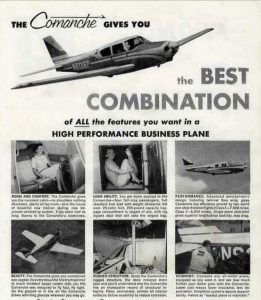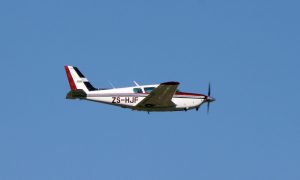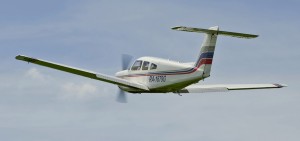The All-Metal Piper Comanche Brought Piper Aircraft Into the Post-War Era
The 250 horsepower Piper PA-24-260 Comanche is a four-seat, low wing airplane with retractable landing gear. As one of Piper’s first all-metal, ultra-aerodynamic airplanes furnished with a comfortable interior, it helped differentiate the company from its early style of slower tube-and-fabric aircraft. Because of the success of the Comanche, sleek, high-performance aircraft like the Piper Seneca and Saratoga were made possible.3
The Piper Comanche features a semi-monocoque construction and laminar-flow wings, and would eventually become a pioneer in cowl-aerodynamics by the third installation of the PA-24-260, with the “Tiger Shark.”3
Today, the Comanche is known for its performance, comfort, and impressive useful load, as well as its undeniable ramp appeal.
History of the Piper Comanche
The Piper PA-24 Comanche 180 first flew on May 24, 1956, the first of what would become one of Piper Aircraft’s most successful single-engine series. The Comanche 180 was introduced in 1957, and the PA-24-250, the 250 HP version, followed soon after in 1958. Piper then skipped directly to the 400 HP PA-24-400 in 1964, before replacing their PA-24-250’s with PA-24-260’s as the standard in August of 1964.3

The Piper Comanche was marketed in the mid-1960’s as “The best combination of all the features you want in a high-performance business plane,” noting its useful load, economy (compared to other all-metal aircraft at the time), and speed. Though more PA-24-250’s were built and sold than the PA-24-2603, modern pilots believe that the 260 HP Lycoming makes the PA-24-260 the most fun and practical of the Comanche line.
Unfortunately, in 1972, torrential rains from Hurricane Agnes flooded a river near Piper’s Lock Haven, PA factory (the Great Susquehanna River Flood of 1972), forcing Piper to abandon production of the Comanche and Twin Comanche, as nearly all airframes, parts, and tooling were destroyed. Piper then focused on the production of the PA-34 Seneca and PA-28R-200 Arrow at its manufacturing plant in Vero Beach, Florida3.
General Characteristics of the Piper Comanche6
The 260 HP Lycoming IO-540 (where the PA-24-260 got its designation) came standard with a constant speed two-blade propeller and retractable tricycle landing gear. It improved upon the PA-24-250’s design with better landing gear and single-fork main legs, which help to create less drag when retracted. It also dedicated itself to improving the interior, by way of better cabin-soundproofing, heating, and ventilation. A member of my flying club has flown in a Piper Comanche, and said she could hardly hear the engine at all! The optional auxiliary fuel system added an addition 30 gallons of fuel, increasing the range exponentially.
| Length | 25 ft (7.62 m) |
| Height | 7.5 ft (2.29 m) |
| Wing Span | 36 ft (11 m) |
| Weight (empty) | 1728 lbs (783.8 kg) |
| Maximum Weight | 2900 lbs (1315.4 kg) |
| Useful Load | 1,372 lbs (622.3 kg) |
| Useable Gas (without upgrade) | 60 gal (227.1 L) |
| Useable Gas (aux. fuel system) | 90 gal (340.7 L) |
| Seats | 4 |
Performance Specifications of the Piper Comanche4
| Maximum Speed | 169 kts (313 kmh) |
| Maximum Cruise Speed | 160 kts (296.3 kmh) |
| Rate of Climb | 1,500 fpm (457.2 m/min) |
| Take Off Roll | 660 ft (201.1 m) |
| Take Off Roll (over 50ft obstacle) | 1,040 ft (317 m) |
| Landing Roll | 650 ft (198.1 m) |
| Landing Roll (over 50ft obstacle) | 1,020 ft (311 m) |
| Range (55% power) | 550 nm (1018.6 km) |
| Range (w/ aux. fuel system) | 950 nm (1759.4 km) |
| Fuel Burn | 14 gph (53 L) |
Piper Tomahawk: From ‘Traumahawk’ to the Perfect Day-Tripper
The Tomahawk is a unique looking two-seat single-engine low-wing cantilever monoplane with a T-tail, sitting on fixed tricycle landing gear, and pulled by a twin-blade propeller. It was originally introduced to the world as the ideal trainer, designed with CFI’s in mind. [Read More]
Piper Comanche 260 Variants2
The Piper PA-24 Comanche had many variants, but the 260 HP Comanche only had three of importance: the PA-24-260B, PA-24-260C, and the turbo-normalized PA-24-260TC.
A total of 1,029 Piper PA-24-260 Comanche’s were sold; 38 of which had carbureted engines, whereas the rest used the 260 HP fuel-injected Lycoming IO-5405.
The Piper Comanche PA-24-260B
The PA-24-260B was in production between 1966 and 1968, and featured an additional six inches of overall length. However, though this model also had six seats compared to the originals four, the six inches of length weren’t added
to the fuselage. Instead, they were added to a longer, pointer propeller spinner. The PA-24-260B also had an extra window on each side of the fuselage to provide a view for the two small seats in the rear (which took the place of the baggage area).
The Piper Comanche PA-24-260C
The PA-24-260C was introduced the year after the PA-24-260B left production, and was produced between 1969 and
1972. The 260C was the most visually unique variant, because it introduced the highly aerodynamic Tiger Shark cowling. The Tiger Shark cowling has a more dramatic taper toward the propeller (which is a three-blade instead of the two-blade both previous variants had), and featured two smaller cowl inlets to the sides of the spinner, instead of the wide opening that surrounded the spinner. The 260C also increased the gross weight to 3200, which brought the useful load up to 1,427- the best of all Comanche’s except the 400 HP model. The propeller shaft was extended to shift the center of gravity forward, balancing out any problems that might have come from an increased gross weight. The 260C kept the two rear seats and additional windows that the 260B introduced.
The Piper Comanche PA-24-260TC

The PA-24-260TC was produced from 1970 to 1972 alongside the 260C, and featured a turbo-normalized Lycoming IO-540-R1A5 and dual Rayjay turbochargers, allowing it to hit 202 kts. (If you’re wondering, as I was, what the difference between turbocharged and turbo-normalized is, check out this article! In short, turbo-normalized means that the engine will perform better at sea-level than a regular turbocharged engine would, as turbocharged engines are meant to perform better at high altitudes.) Only 26 260TC’s were built.
Modifications and Upgrades for the Piper Comanche7
Most of the upgrades and modifications for the Comanche variants are for pilots who have the need… the need for speed. The aerodynamics of the airplane can be improved in many ways, some big, some small. In addition to speed, many of these modifications improve the aesthetics for those pilots who desire a more modern look and comfort.
The LoPresti Wholey Cowl
The LoPresti Wholey Cowl is available for the PA-24-260 and PA-24-260B (the 260C’s Tiger Shark cowling is already awesome), and is reported to improve cruise performance by as much as 15 mph (or 13 kts), which can really make a difference in those long range flights. The Wholey Cowl Mod is a low-drag, high induction system which costs upwards of $15,000.
Replacement Windows
The Comanche benefits greatly from replacement windows, but also can heat up the cockpit substantially in warmer weather. Any increase in window area increases the visibility, which is important, and if you get tinted glass, it’ll reduce the solar heating potential. You can even get a windscreen replacement which modifies the roof line by bringing it up over the pilots head for a little more visibility. You can buy the kit and install it yourself for $1,500.
Wing Tip Modifications1
Some pilots find that the Comanche wingtips, which are round, look a little too “retro.” You can get them replaced with either downturned wingtips or upturned finlets, which both benefit the Comanche aerodynamically (in a small way), but are mainly for aesthetic value.
If you’d rather go for range than ramp appeal, you can invest in tiptanks, which add 30 gallons (15gal to each wing), increasing the range by a couple hundred nautical miles as well as a 200 lb gross increase. The tiptanks usually run somewhere around the $10,000 mark.
Piper Arrow: Continually Refining a Winning Design
Airplane manufacturers often find that one of their designs “sticks” to pilots, and they take that winning design and modify it, continually improving on the original design over decades of production. For Piper Aircraft, the PA-28 was it. [Read More]
Operating and Purchase Costs(AOPA)
Most likely because it’s a high performance complex aircraft, it’s not exactly cheap to insure a Piper Comanche. Generally, pilots are quoted around the $2,000-2,500/yr mark. Compared to many high performance aircraft, the Comanche isn’t too expensive, selling on the used market for anywhere between $36,000-$70,000 depending on modifications and condition. Considering they sold for $32-36,000 when they were first introduced in the mid-sixties to early seventies, it’s kind of surprising they’re not more expensive1.
Conclusion
Our flying club is hoping to add a Piper Comanche to our line up soon, so I wanted to take a closer look at the specifications and such. After doing this research, it seems like the perfect traveling plane, and with its high horsepower, it’ll perform better at altitude, which is important here in the Sierra Nevada Mountains. I personally think the regular 260 with speed and range modifications would be the way to go, because baggage area makes more sense to me practically than two extra seats. Many of the Piper Comanche’s available on the used market already come equipped with substantial upgrades and modifications, which makes it both easier on you, the prospective owner, and hypothetically less expensive.
*Featured image “Edenvale Aerodrome – Gathering Of The Classics – 2007” taken by Ken Mist, used under license CC BY 2.0.*
References and Resources:
1 – Piper Comanche, Thomas A. Horne, AOPA, Retrieved 4-7-17
2 – Piper PA-24-260 “Comanche 260,” Skytamer, Retrieved 4-7-17
3 – Piper PA-24 Comanche, Wikipedia, Retrieved 7-28-17
4 – Piper PA-24-260 Performance Data, Rising Up Aviation, Retrieved 4-7-17
5 – Comanche 260 Series, Comanche Flyer, Retrieved 4-7-17
6 – Piper “Comanche,” Plane & Pilot Magazine, Retrieved 4-7-17
7 – Popular Piper Comanche Modifications, Piper Flyer Association, Retrieved 4-7-17

















Leave a Reply